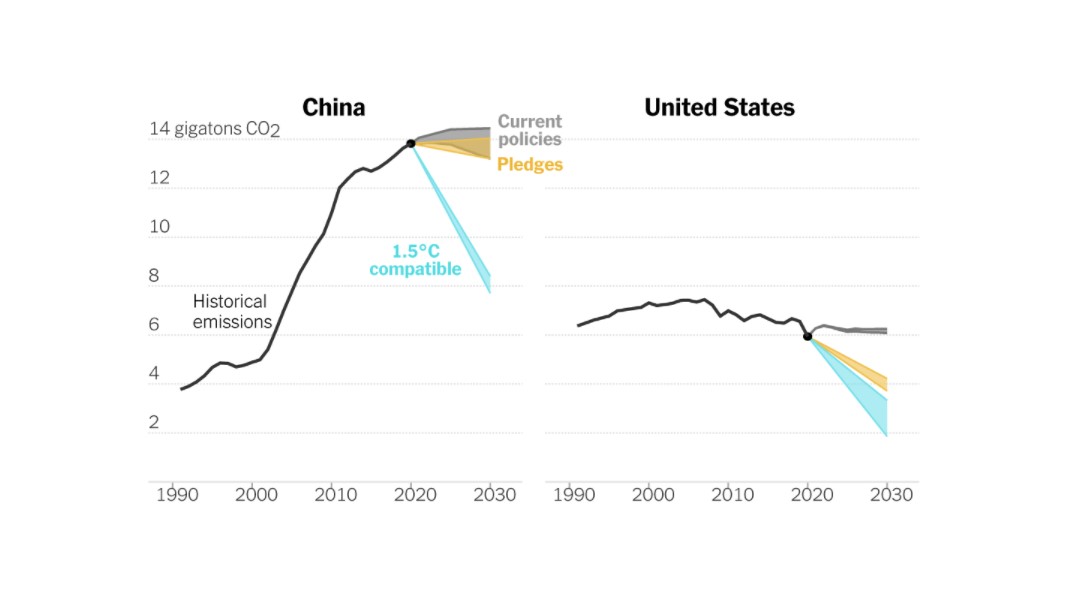The New York Times
By Brad Plumer, Blacki Migliozzi and Nadja Popovich
Nov. 1, 2021
As the United Nations climate summit in Glasgow gets underway this week, many countries have vowed to do more to fight climate change. Yet those plans still fall short of what’s needed to avoid a dangerous rise in global temperatures.
The charts below show emissions pathways for the world’s 10 biggest polluters, based on data from Climate Action Tracker. Together they account for more than two-thirds of the world’s greenhouse gas emissions.
Largest Emitters

The world’s four biggest emitters — China, the United States, the European Union and India — are responsible for just over half of global greenhouse gas output and are considered key to limiting future impacts from climate change.
The world’s four biggest emitters — China, the United States, the European Union and India — are responsible for just over half of global greenhouse gas output …
These charts illustrate how emissions are projected to change through 2030 under current climate policies, how much each country has promised to curb its emissions, and what would be needed to limit total global warming to 1.5 degrees Celsius (2.7 degrees Fahrenheit) above preindustrial levels, a goal that many leaders and scientists increasingly say is necessary to avoid the worst effects from heat waves, droughts, wildfires and flooding.
In the run-up to the summit in Glasgow, both the United States and the European Union made new promises to cut their emissions roughly 50 percent below 2005 levels by 2030.
But neither government has yet enacted sufficient policies to meet those pledges.
European nations are debating a large new clean-energy package, while the Biden administration is still trying to pass major climate legislation through Congress.
… both the United States and the European Union made new promises to cut their emissions roughly 50 percent below 2005 levels by 2030 … but neither government has yet enacted sufficient policies to meet those pledges.
China
China, the world’s largest consumer of fossil fuels, has said its emissions would peak sometime “before 2030,” and the nation plans to get 25 percent of its energy from clean sources like wind, solar or nuclear power by then.
Environmentalists had urged China to set more ambitious near-term targets ahead of Glasgow, but the country, which is currently struggling to rein in its appetite for coal power, kept its goals unchanged from those announced a year ago.
India
India, for its part, has not yet formally set a date for when its emissions will peak, with officials arguing that the country is still much poorer than other major emitters and needs more time to develop its economy. (India’s emissions per person are roughly one-fourth those of China and one-seventh those of the United States.)
The country has announced goals for increasing the use of cleaner energy sources like solar power and slowing its growth in fossil-fuel consumption, but it has asked for assistance from wealthier countries to accelerate its efforts.
Other Large Emitters

Under the 2015 Paris climate agreement, countries are free to set their own national goals for tackling global warming.
Some countries, like Russia, have set targets that are far above where their emissions are actually expected to be in 2030 under current energy policies.
Iran, for its part, is one of a handful of nations that has not ratified the Paris agreement and has few climate policies on the books.
Canada and Japan recently set stricter emissions targets through 2030 in the run-up to the Glasgow summit. Neither country has yet put in place the sorts of energy policies that would achieve those goals, although Canada’s government is counting on a hefty carbon tax to restrain fossil fuel use going forward.
If countries all follow through on their current near term pledges, the world could potentially limit warming to roughly 2.4 degrees Celsius (4.3 degrees Fahrenheit) above preindustrial levels by 2100, according to Climate Action Tracker. But many scientists say that is still too risky.
To hold global warming to a lower level of 1.5 degrees Celsius, the world’s nations would all need to do much more, collectively cutting their fossil fuel emissions roughly in half this decade.
To hold global warming to a lower level of 1.5 degrees Celsius, the world’s nations would all need to do much more, collectively cutting their fossil fuel emissions roughly in half this decade.
But how that responsibility gets divided up is a perennial sticking point.
Many lower income countries, including India, say that wealthier nations like the United States — which has historically been the world’s biggest emitter — should slash greenhouse gases even faster than they have promised, to give the rest of the world more time to transition away from fossil fuels.
Land-Use Emitters

Some countries, notably Brazil and Indonesia, don’t just produce greenhouse gas emissions from fossil fuels in homes, cars and factories.
They also release enormous amounts of carbon dioxide each year when they burn and clear away carbon-rich rain forests and peatlands for agriculture.
Both countries have recently submitted new climate promises, though Climate Action Tracker rates current policies in both countries as “insufficient.”
In Brazil, rates of tropical deforestation declined rapidly in the 2000s but have accelerated again since the election of President Jair Bolsonaro in 2018 (the data in the chart only runs through 2016 and does not reflect this uptick in forest clearances).
Mr. Bolsonaro has pledged to end illegal deforestation this decade if the international community pays billions of dollars for conservation efforts, though his promises have been met with skepticism by environmentalists and Indigenous groups.
Indonesia has taken steps to crack down on the clearing of tropical forests for palm oil plantations. But researchers have questioned how well those efforts are working, and the country regularly sees widespread fires, often deliberately set to clear land, that release large amounts of carbon dioxide into the atmosphere.
At the Glasgow summit, diplomats are expected to discuss ways to accelerate climate action, whether by more deeply slashing greenhouse gases like methane, providing financial aid to developing countries for clean energy or strengthening programs to protect forests.
While some leaders, like President Biden, have said they want to keep alive the goal of limiting global warming to 1.5 degrees Celsius, scientists warn that goal could soon be out of reach without immediate and rapid action.
Note:
The pledged pathway in the charts above reflect unconditional pledges only. The 1.5°C-compatible ranges are based on two approaches used by scientists at Climate Action Tracker to assess how responsibility for global emissions reductions might be divided up between countries: A modeled domestic pathway and an effort-sharing pathway. The methodology is explained in more detail here.
Originally published at https://www.nytimes.com on November 1, 2021.












